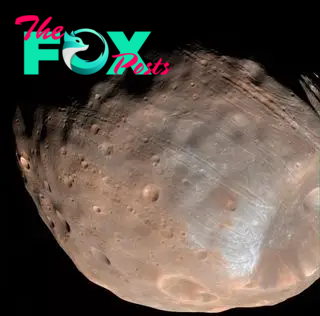Science
Lost photos suggest Mars' mysterious moon Phobos may be a trapped comet in disguise
Mars' moon Phobos may actually be a comet — or at least part of one — that was gravitationally captured by the Red Planet long ago, a new preprint study based on previously unpublished photos suggests.
For years, researchers have puzzled over the origins of Phobos and its twin, Deimos. Some have theorized that the moons are former asteroids lured in by Mars' gravity, because their chemical composition is similar to that of certain rocks in the main asteroid belt between Mars and Jupiter. However, computer models simulating this capture process have not been able to replicate the pair's near-circular paths around Mars.
Another hypothesis suggests that a giant impact, like that which created our moon, gouged the duo out of the Red Planet; but Phobos has a different chemical composition from Mars, making this scenario unlikely, too.
Figuring out exactly how Phobos was born is one of the aims of the Japan Aerospace Exploration Agency's Martian Moons eXploration (MMX) mission, slated to launch in 2026. Sonia Fornasier, an Astronomy professor at the Paris Cité University and lead author of the new study, is an instrument scientist for the MMX mission. While she and other scientists were analyzing images to fine-tune the spacecraft's planned path, Fornasier stumbled upon unpublished photos.
Related: Hundreds of black 'spiders' spotted in Mysterious 'Inca City' on Mars in new satellite photos
Taken by high-resolution cameras onboard the Mars Express spacecraft, a European Space Agency (ESA) orbiter that has studied Mars and its moons since 2003, these 300-odd images exquisitely document Phobos' features. That includes the 9-kilometer-wide (5.6-mile-wide) Stickney crater, Phobos' largest landmark.
Fornasier and her colleagues used the snapshots to analyze the intensity of sunlight Phobos reflected from different angles. This technique, called photometry, allowed them to determine how much light Phobos reflected when the sun was right in front or at an offset angle.

The researchers discovered that Phobos's surface didn't reflect light uniformly. Some regions, like the northeastern rim of the crater, were highly reflective. But the team's analysis also showed that overall, Phobos's surface appeared noticeably brighter when the sun was directly overhead. This phenomenon, called an opposition surge, is characteristic of many airless solar system objects. Also, the researchers found that Phobos's surface was porous, like sand. This led the team to suggest the moon's surface may be cloaked by a thick dust layer with grooved particles, whose shadows vanished when directly illuminated.
-

 Science2d ago
Science2d agoInside Capitol Hill’s Latest UFO Hearings
-

 Science2d ago
Science2d agoYou Won’t Want to Miss the Leonid Meteor Shower. Here’s How and When You Can See It
-

 Science3d ago
Science3d agoHere’s What Trump’s Win Means for NASA
-

 Science6d ago
Science6d agoWhy Risky Wildfire Zones Have Been Increasing Around the World
-

 Science6d ago
Science6d agoIt’s Time to Redefine What a Megafire Is in the Climate Change Era
-

 Science1w ago
Science1w ago4 Astronauts Return to Earth After Being Delayed by Boeing’s Capsule Trouble and Hurricane Milton
-

 Science1w ago
Science1w agoThe Elegance and Awkwardness of NASA’s New Moon Suit, Designed by Axiom and Prada
-

 Science1w ago
Science1w agoSpaceX Launches Its Mega Starship Rocket. This Time, Mechanical Arms Catch It at Landing



























